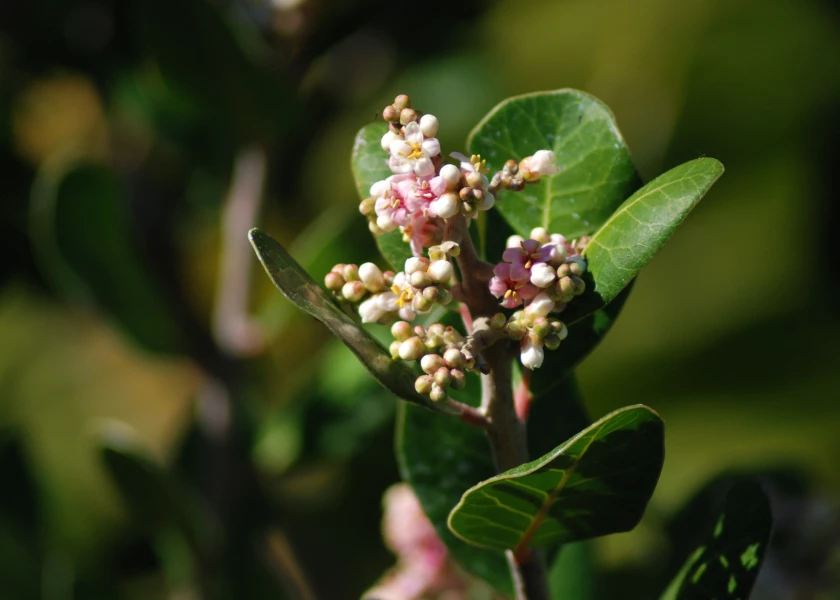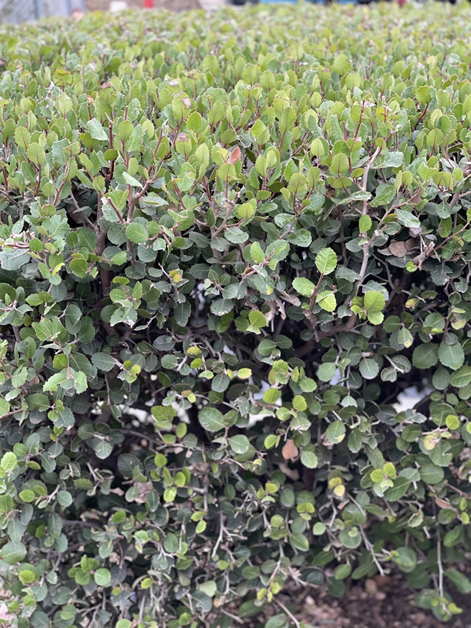Lemonadeberry shrub is just right for the times

Lemonadeberry fruit is a sour but edible treat.(Meredith French)
Established plants beautify landscape and thrive on little water in San Diego region
BY MICHAEL HARRELSON
(This article first appeared in the San Diego Union-Tribune on January 8, 2022)
For San Diego gardeners, the Lemonadeberry shrub (Rhus integrifolia) is the landscape plant perfect for our times. Considering the ongoing drought in Southern California, a low-water, low-maintenance, deer-resistant evergreen, boon-to-native-wildlife addition to the landscape is just what the doctor ordered. Beautiful to look at with edible fruit, it is a good replacement for some of the more tropical bushes, such as hibiscus, that commonly dot the San Diego landscape.
Lemonadeberry can be used in many ways by San Diego gardeners. Because of its mature size (10 feet by 10 to 30 feet), density and tolerance of heavy pruning, it is often trimmed into a hedge. It can be a striking central feature in a large yard and does well on slopes. It loves full sun and, once it is established, can thrive without supplemental irrigation, surviving nicely on whatever rainfall it can get.
When in bloom, it is an eye-catching mound of white-pink flowers that attract bees, butterflies and hummingbirds. The flowers become small clusters of small, red berries enjoyed by native bird species and humans alike.
The fruit of the Lemonadeberry clusters between the leaves at the end of the twigs and looks similar in size and color to the arils of the pomegranate. They are sour tasting and loaded with vitamin C. Original inhabitants of our area, the Kumeyaay, harvested the berries of Rhus integrifolia and ate them fresh or ground them to use in a type of tea. Modern-day hikers place the Lemonadeberry seeds in their canteens to add flavor and nutrients to their water reserve.
Commonly found in nurseries in 1-gallon containers, Lemonadeberry grows well in sandy, medium-loam or even rocky soil. It will adapt to soil that is not particularly nutrient rich as long as drainage is good. Like many drought-tolerant plants, it will not do well if left to sit in a wet soil environment. Although considered by some as an “indestructible” plant, it will succumb to root rot if it placed in poorly draining clay soil.
Like all trees and large shrubs, Lemonadeberry should be planted in a hole twice the diameter of the pot in which it was purchased and with the crown of the root ball resting slightly above the ground level so that water moves away from the main stem. Even a terrific low-water plant like Lemonadeberry will need regular irrigation in the first year to ensure that it becomes well established in its new home. Once that has occurred, watering can be reduced over time and, eventually, stopped altogether.

Lemonadeberry can be used to form hedges or privacy shields.(Leah Taylor / UC Cooperative Extension)
Replacing a high-water-use plant with a more drought-tolerant variety, such as Lemonadeberry, will not, by itself, save water. Planting low-water alternatives is a means to an end. Saving water in the landscaping can only happen when the amount of water applied is reduced. That requires both changing irrigation schedules and reducing the quantity of water being emitted from the system. Low-water landscaping accommodates that process by giving homeowners the opportunity to include those plants that require less to thrive and survive. As noted, all plants need more water in the beginning to make sure that their root systems will grow to a size that allows them to sustain themselves. Low-water plants will eventually reach a point of sustainability where the frequency and amount of water they need to do that can be cut back or curtailed.
The UCCE Master Gardener Association of San Diego County and other local organizations, such as the San Diego Botanic Garden and California Native Plant Society, have lists of drought-tolerant plants from which to choose. The San Diego County Water Authority publishes a roster of suggested low-water alternatives called “Nifty 50: Plants for Water Smart Landscapes.” Both the San Diego Botanic Garden and the Water Conservation Garden in El Cajon have targeted low-water landscaping in their gardens and have plants in situ for visitors to see and decide for themselves what fits their yard’s color palate. Lemonadeberry and larger plants of its ilk, like Grevillea (spider flower), Chaumelaucium (waxflower) and Ceanothus (California lilacs), are planted along the paths. Low-water plants to partner with large shrubs, such as vines, succulents, groundcover, perennials, trees and grasses are also on display.
It is said that we can’t conserve our way out of this drought, but we will all have to find ways to use less water, and since irrigating the landscape can consume a large amount of a household’s water budget, that is a good place to start.
A San Diego gardener’s New Year’s resolution: Be a part of the solution. Try low-water plants.
Harrelson has been a San Diego Master Gardener since 2012 and currently serves as the group’s vice president of communications. He practices low-water landscaping at his home in Jamul.

